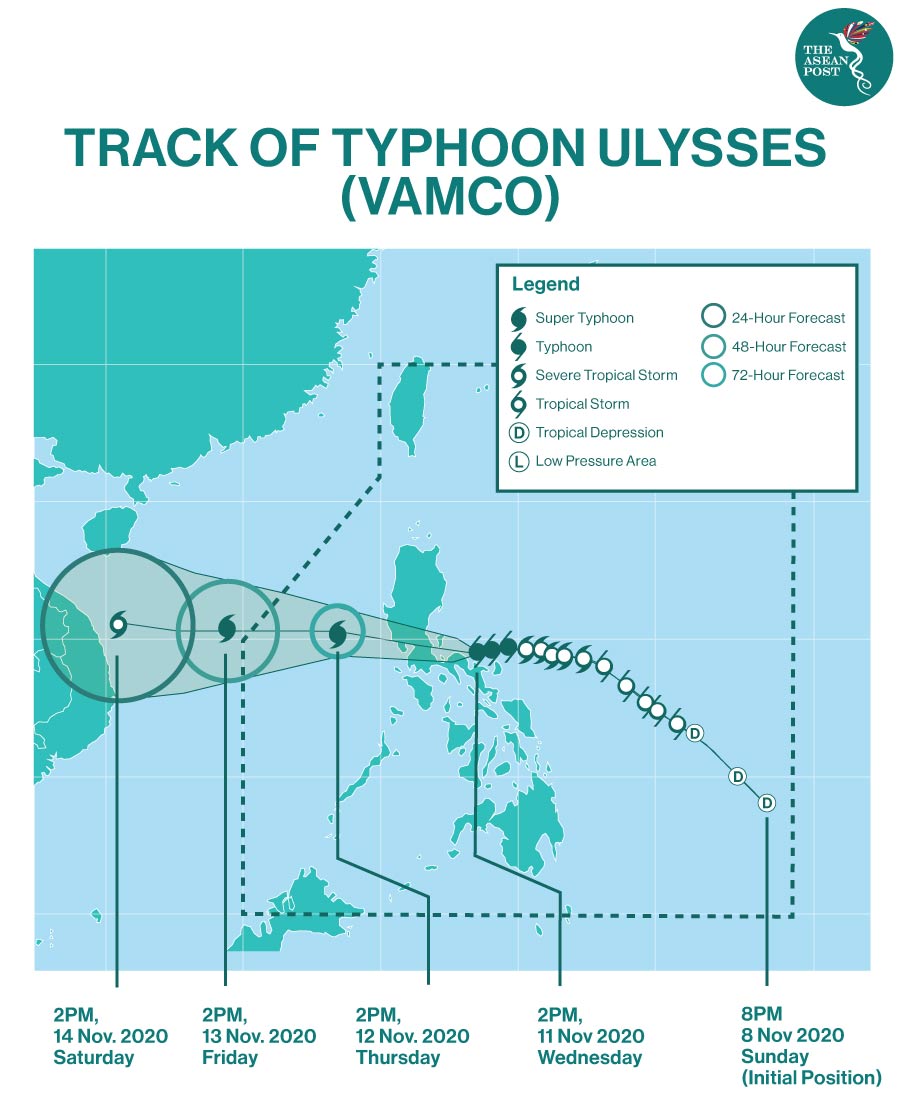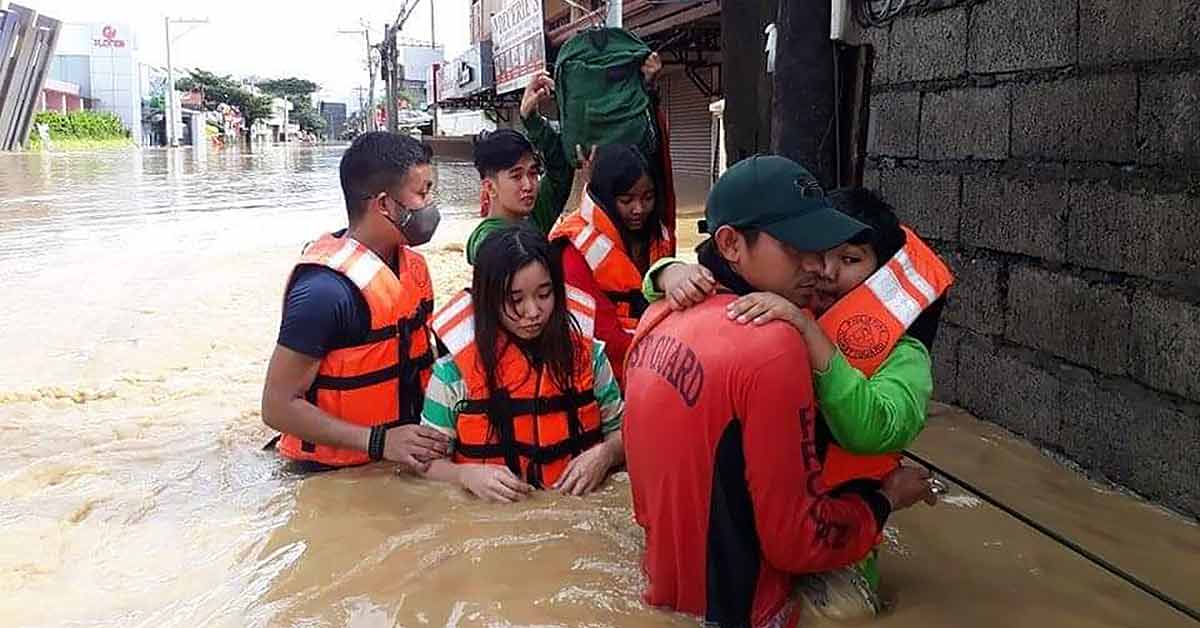The Philippines just recently experienced five typhoons in a row and that’s within at least a month only. These are typhoons Quinta, Rolly, Siony, Tonyo, and now typhoon Ulysses that just made landfall in the country last Wednesday evening (11 November).
Though all these typhoons, one way or the other, have left trails of devastation in their wakes and that includes not only physical injuries, human casualties, and material/property damages but even psychological harm to those who are most affected, the ones that caused the most damage and destruction were typhoons Rolly and Ulysses.
However, based on reports from the National Disaster Risk Reduction and Management Council (NDRMMC), it can be deduced that the combined magnitude of casualties of typhoons Rolly and Ulysses compared to typhoons Ondoy and Haiyan (Yolanda) are much lower.
For instance, typhoon Rolly incurred casualties of 25 deaths, 399 injured and 6 missing persons, while typhoon Ulysses, as of 14 November, has a death toll of 37, 22 persons injured, and 15 missing people.
Typhoon Ondoy on the other hand, had a death toll of around 464, 529 injured, and 37 missing persons. Whereas typhoon Yolanda had a death toll of 6,300, 28,688 injured, and 1,062 missing persons.
Duterte’s Pledge
Despite the five successive typhoons in the Philippines in more or less a month, President Duterte in a public address to the nation a day after the onslaught of Typhoon Ulysses on 12 November assured Filipinos that “no one will be left behind.”
Duterte said, “As President, I guarantee you that your government will do its best to provide assistance in the form of shelters, relief goods, financial aid, and post-disaster counselling. Rest assured; the government will not leave anybody behind.
We will get through this crisis. Kapit po tayo mga kababayan (Let us hold on to each other my fellow men). Magbayanihan tayong lahat (Let us help one another).”
According to Presidential Spokesperson Harry Roque, Duterte assures Filipinos that as a nation, they will get through the aftermaths of typhoons Rolly and Ulysses as the Philippine government vows not to leave anyone behind in the on-going search, rescue, and evacuation operations, response, and relief efforts being undertaken by concerned government agencies in coordination with local government units (LGUs) and the private sector.
Thus, in this regard, it is imperative to look at how the Duterte administration has responded to the aftereffects of typhoon Ulysses following the aftermaths of typhoons Quinta, Rolly, Siony, and Tonyo.
Aftermath Of Typhoon Ulysses
As of 14 November (Saturday), the National Disaster Risk Reduction and Management Council (NDRRMC) reported that typhoon Ulysses had affected a total of 285,978 families or 1,110,910 persons in 3,811 barangays across all affected regions, of which 80,858 families or 306,340 individuals are currently being served inside 2,983 evacuation centres. Whereas there are 16,675 families or 63,536 persons being served outside the evacuation centres.
Also, there are a total of 216 road sections and 99 bridges across the distressed regions that are affected by flooding, mudflow, landslides, swollen rivers, and soil/rock collapse. From this number, 175 road sections and 94 bridges are not passable as yet.
In transportation hubs and major thoroughfares, 330 passengers and 184 rolling cargoes in seaports are still stranded as 69 ships/boats are on stay put while awaiting clearance to sail.
Also, a total of 310 cities and municipalities across all affected regions experienced a power outage. But power has been restored to 16 cities and municipalities already as of Saturday. Whereas a total of 50 municipalities have experienced water supply interruption.
Meanwhile, the damage to agriculture across all the affected regions as of Saturday has already amounted to more than PHP 999.8 million (US$20.7 million), while damage to infrastructure in Region 1 and MIMAROPA alone amounted to PHP 253.1 million (US$5.2 million) already. Likewise, a total of 3,013 houses were damaged of which 305 were totally damaged and 2,708 are partially damaged.
Preparedness
The relatively very low casualties in the aftermath of typhoon Ulysses can be attributed to the relatively high level of pro-activeness and preparedness of all concerned agencies according to concerned government officials. Before the onslaught of typhoon Ulysses, Defense Secretary and NDRRMC Chair Delfin Lorenzana said that the NDRRMC and the Office of Civil Defense (OCD) were already on alert, as well as its regional offices in areas that were affected by the typhoon.
In terms of pre-emptive evacuation, a total of 64,552 families or 231,312 individuals were evacuated before the onslaught of typhoon Ulysses. Likewise, a total of 123 Emergency Alert and Warning Messages (EAWM) for the dissemination of telecommunication companies in the affected areas were fully used and mobilised as well.
On the part of the affected LGUs, 99 percent of local chief executives were present in their respective areas of responsibility of which all of whom have convened their local DRRMCs, established local emergency operation centres, and activated their disaster and emergency response teams according to the Department of Interior and Local Government (DILG).
Response, Rescue And Evacuation
In the aftermath of typhoon Ulysses, around 25,000 officers from the Philippine National Police (PNP) were deployed to assist with the search, rescue, and evacuation operations in affected areas. From this number, 1,000 PNP personnel were deployed and are currently manning the evacuation centres in areas affected by the typhoon. An additional 994 police personnel as an added force were also deployed to manage and secure these evacuation centres.
In as far as rescue operations are concerned, as of 13 November (Friday), the PNP rescued 104,857 individuals including 2,123 infants and elderly in separate search and rescue operations. The PNP continues to monitor and respond to the situation in the affected regions to date.
As of Friday, the Philippine Coast Guard (PCG) had already deployed a total of 89 teams, composed of 522 personnel, with 10 rubber boats, six aluminium boats, 11 multipurpose vehicles, and three trucks. The PCG also responded to the evacuation and rescue operations in Metro Manila, Rizal, and Cavite.
It’s 41 newly acquired rubber boats were a huge boost to the PCG rescue and evacuation efforts. Its Airbus light twin-engine helicopters were also deployed to conduct aerial rescue and retrieval operations.
Meanwhile, the Armed Forces of the Philippines (AFP) is currently assisting in the clearing operations of roads and bridges, debris, and landslides. It is also assisting other agencies and LGUs in their response and relief operations. The AFP also conducted search, rescue, and evacuation operations. As of 13 November, the AFP was able to rescue 138,272 individuals.
The DPWH on the other hand is continuously working on clearing operations in affected areas. The agency deployed a total of 483 equipment/service vehicles and 2,943 personnel in areas affected by typhoon Ulysses.
Cagayan Valley Rescue/Retrieval Ops
As of 14 November, a total of 3,776 personnel was deployed for the search, rescue, and retrieval operations from the combined forces of the AFP, PNP, Bureau of Fire Protection, and PCG.
The PCG also deployed one multipurpose vehicle, one truck, several newly-procured rubber boats, two buses, one 12-wheeler boom truck, two M-35 trucks, three generator sets, and 64 drums of fuel for the rescue air assets and vehicles. The two Coast Guard Airbus light twin-engine helicopters and its islander plane were also deployed to conduct aerial rescue and extraction operations.
Also, two Huey helicopters were deployed in Region 2, particularly Tuguegarao, for rescue and relief delivery operations to communities in isolated areas not passable by roads at the moment. One Sikorsky S76 SAR helicopter has also been deployed to help as well in the rescue operations.
The C-130 air asset of the AFP is also being mobilised, while two additional Bell 412 helicopters have also been deployed. DSWD and DOH regional offices, on the other hand, are currently providing relief assistance to affected residents of Cagayan Valley and Isabela.

Relief And Assistance
In as far as the total cost of assistance provided to affected communities, as of Saturday (14 November), it has already amounted to around PHP 14 million (US$290,000), of which around PHP 13.8 million (US$286,000) was from the Department of Social Welfare and Development (DSWD) and PHP 466,879 (US$9,688) from the LGUs.
Thus far, the DWSD has total standby funds amounting to PHP 1.4 billion (US$29 million). From this figure, around PHP 888.6 million (US$18.4 million) is the standby funds in the agency’s central office and field offices, while PHP 847.2 million (US$17.5 million) is the available Quick Response Fund (QRF). As of this Saturday, a total of 275,591 family food packs (FFPs) costing PHP 123.4 million (US$2.5 million), other food items amounting to PHP 187.1 million (US$3.8 million), and non-food items (FNIs) amounting to PHP 275.7 million (US$5.7 million) are available. Also, the Department of Budget and Management (DBM) has already replenished the DSWD's quick response fund amounting to PHP 600 million (US$12.4 million) which will be used to aid more typhoon-hit families.
The DSWD has also ensured the efficient and effective delivery of protective services to affected families and individuals. It provided health-protective gear to evacuees so that they would also be protected against the risks of the coronavirus disease (COVID-19) while staying at the evacuation centres.
In the management of evacuation centres, it ensures that children and women-friendly spaces are made available, minimum health standards are practiced in coordination with the Department of Health (DOH), and psychosocial support is extended to Internally Displaced Persons (IDPs). The DSWD is still on red alert and is continuously monitoring the provision of relief assistance to affected communities.
The DOH has prepositioned PHP 26.8 million (US$556,000) worth of drugs, medicines, and supplies in its regional offices in affected areas, and PHP 56.1 million (US$1.1 million) worth of commodities in its regional warehouses that are ready for distribution. The DOH has assured the public that the majority of its hospitals nationwide are fully functional and operational. The health agency also provided hygiene kits, collapsible water containers, assorted medicines, and face masks to affected communities.
For the agricultural sector, the Department of Agriculture has initially distributed around PHP 176 million (US$3.6 million) worth of rice seeds and fertilizers to farmers in Pulilan and Malolos, Bulacan. The agency is also offering affected farmers PHP 25,000 (US$518) financial assistance from its Survival and Recovery (SURE) loan program.
Conclusion
Based on observation, the national government in cooperation with LGUs and the private sector including non-government organisations (NGOs) seems to have been ready, prompt and prepared in responding to the aftermath of typhoon Ulysses.
The fast mobilisation of search, rescue, and retrieval/evacuation operations, and the speedy extension of relief and assistance to affected communities from concerned government agencies show that, thus far, the Duterte administration is in control of the situation.
This is despite the president again being physically absent at the NDRRMC press briefing last Friday (13 November) because he was attending the 37th ASEAN Summit and Related Summits hosted by Vietnam.
Related Articles:

